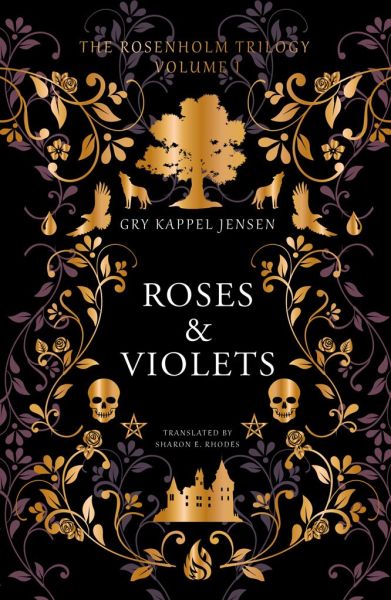Play With Magic
Roses & Violets (Rosenholm Trilogy, volume 1)
By Gry Kappel Jensen (Translated by Sharon E. Rhodes)

15 Nov, 2023
2019’s Roses & Violets is the first volume of Gry Kappel Jensen’s Rosenholm Trilogy. The 2023 English translation is by Sharon E. Rhodes.
Four very different young women receive invitations to the mysterious Rosenholm Academy on Denmark’s Zealand Island. Maternal Chamomile; timid, sheltered Kirstine; grumpy Malou; and rich Victoria are all potential mages. Rosenholm can teach them how to safely use (Norse-flavored) magic.
Another way to look at it is that Rosenholm will provide a killer with potential victims.
There are four schools of magic: Earth (history), Growth (life), Blood (sacrifice), and Death (spirits). Of the four, Blood has the worst reputation. Sacrifice need not be self-sacrifice.
Conveniently, each of the four protagonists belongs to a different school: Chamomile has an affinity for Growth, Kirstine for Earth, Malou for Blood, and Victoria for Death. Equally conveniently, this is not the sort of magical school that embraces magical apartheid; the quartet are roommates.
Their first year involves the usual onerous study under teachers ranging from helpful to almost certainly a villain dabbling in forbidden ha-ha-ha magic. Also, there’s the matter of circumventing the surprisingly ineffective rules banning student romances. However, these cannot distract the four from a great mystery: who murdered Trine back in the 1980s? and what must be done to grant the dead girl rest so she will leave Victoria alone?
While the four pursue the old puzzle ineffectively, they become aware of another, ongoing mystery. A student is badly injured in what seems to have been a Death-related experiment gone wrong. In fact, she was targeted and the guilty party is not done. Who is responsible? Are they connected to Trine’s decades-old murder? And which of the four friends have been selected as the next victim?
~oOo~
I am trying hard to avoid mentioning a certain magical boarding school series here, its creator having enthusiastically embraced the way of the TERF. That is impossible in this case, as the novel in hand is methodically derivative of that series. There’s a sorting hat analog, and a Snape analog, not to overlook a head of the school whose management style really deserves a comprehensive investigation and a lengthy jail term.
The differences begin with the magic, specifically Norse themed1 rather than being based on arbitrary spells unified by their use of crappy Latin. The stakes are much smaller, the big bad’s goals involving individuals rather than the world. The stakes may be smaller but they matter to the girls, since one of them is probably the next target.
While that other series explored a wide assortment of terrible policies schools could pursue, Jensen finds one that was omitted: teachers dating students. There are any number of reasons why student-teacher relationships are ill-advised. In novels of this sort, it often turns out that the lovers are very special people far too sparkly to be constrained by mere common-sense guidelines. In this novel, the romance is a terrible idea that ends badly. Who could have predicted this entirely predictable outcome?
Indeed, the most striking way in which the novel differs from its model is that the staff face consequences for pursuing terrible policies and for being awful at their jobs. The clearly evil Blood magic teacher is gently ushered out the door for more suitable employment elsewhere. Others face public disgrace. While it is true that one student outright kills another student without consequences2, it was self-defense and she is one of the protagonists. Plot immunity.
As for being terrible at their jobs: the quartet are half-hearted detectives at best, chasing false conclusion after false conclusion. In their defense, their lives are filled with distractions such as schoolwork and romance. Nor do they have any guidance; none of the four magical schools focus on private detection. There are no Nancy Drews, Lumikki Anderssons, or Kalle Blomkvists at this school … but why would there be?
Roses & Violets is available here (Amazon US), here (Amazon Canada), here (Amazon UK), here (Barnes & Noble), and here (Chapters-Indigo). I did not find Roses & Violets at Apple Books.
1: Norse practices being bloody and Kirstine having been raised in a particularly narrow-minded Christian cult, certain school customs are upsetting to her. Good thing she is not Blood.
2: No consequences for the killer, I mean. The consequences for the person they kill are significant, mostly involving dying and then being dead.
